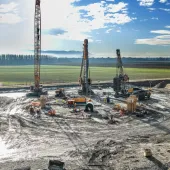Bauer builds complex Cologne excavation project
Bauer constructs deep foundation pit for new LVR office in Cologne
Bauer Spezialtiefbau is leading specialist foundation work for a major new office development in Cologne, Germany, where it is constructing an 8-metre-deep excavation pit under extremely challenging site conditions.
The pit is being built ahead of the 18-storey, 69.5-metre-tall administrative building for Landschaftsverband Rheinland (LVR), which is due to complete in 2028. Bauer’s engineering work, involving a range of concrete and geotechnical solutions, is scheduled to be completed by early 2026.
The excavation pit extends beneath the site of a former underground garage in the busy Deutz district of the city. A mix of retaining structures have been deployed, including contiguous pile walls with timber and shotcrete facing, secant pile walls, and jet-grouted underpinning to strengthen the old basement walls.
“Constructing the excavation pit for the new LVR building requires a range of specialised foundation engineering methods,” said Moritz Hahn, project manager at Bauer Spezialtiefbau.
One particularly complex part of the project involves the installation of a secant pile wall directly on the underground garage roof slab, supported by 1,000 heavy-load props. This ceiling structure has been further stabilised by steel pipe bracing up to 30 metres long. Drilling rigs are operating directly above, placing heavy demand on site safety and logistical precision.

The project also includes a large-scale groundwater management system. A 500-metre discharge pipe carries water pumped from the site to the Rhine, with the system capable of handling up to 4,000 cubic metres per hour.
A range of heavy and compact rigs are being used on site, including the BAUER BG 24 H for bored piles up to 880 mm in diameter, KLEMM KR 806 and KR 401 rigs for ground anchor installation in tight spaces, and the RG 16 T from RTG Rammtechnik for vibratory work.
Work is progressing despite the presence of up to five specialist disciplines operating at once in restricted areas. Much of the site is supported by existing retaining walls secured with walings and anchors.
Digital tools have been integral to the project's planning and delivery. Bauer used 3D modelling to analyse site constraints and prevent equipment clashes, while software platforms including fielddata and digital construction diaries have helped monitor drilling accuracy and site progress.
“Digital tools help us to control complex processes efficiently. From 3D modelling to the digital construction diary, they enable us to master all the challenges,” said Hahn.
The LVR project is another example of concrete construction under difficult urban conditions, combining heavy equipment, specialist piling methods, and digital planning to ensure precision at depth.



